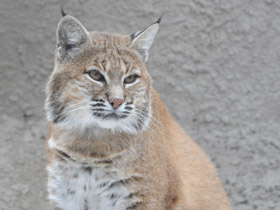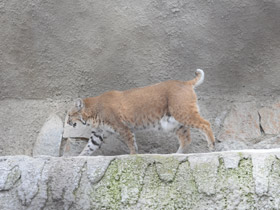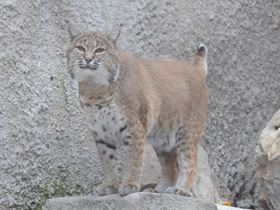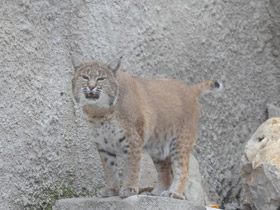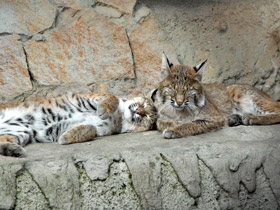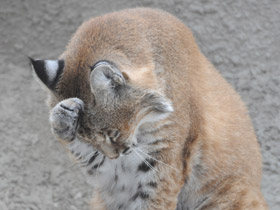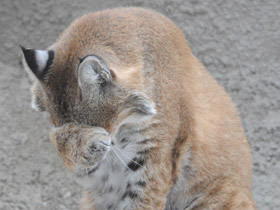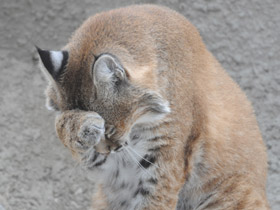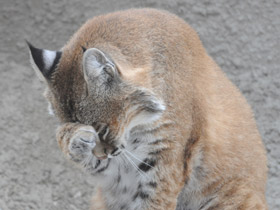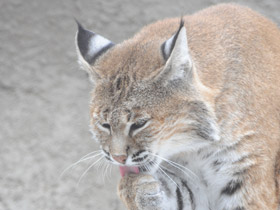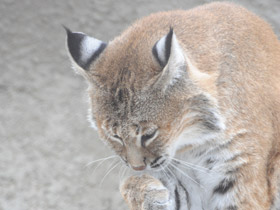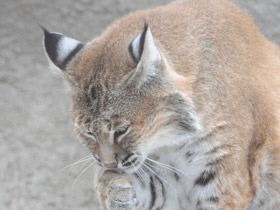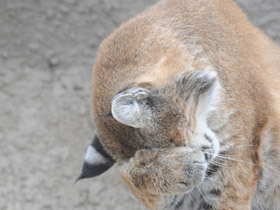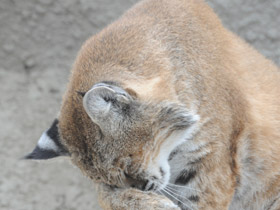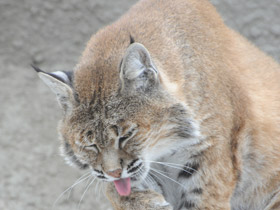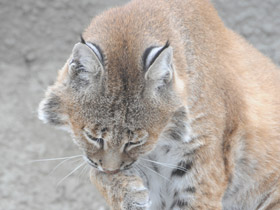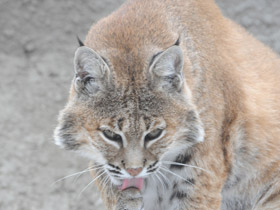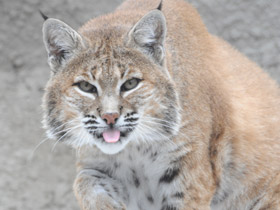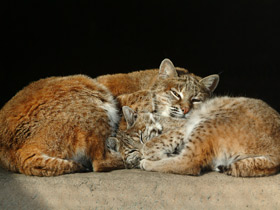The bobcat, the red lynx (Lynx rufus)
The bobcat (Lynx rufus), also known as the red lynx, is one of the four extant species within the medium-sized wild cat genus Lynx. Native to North America, it ranges from southern Canada through most of the contiguous United States to Oaxaca in Mexico. It is listed as Least Concern on the IUCN Red List since 2002, due to its wide distribution and large population. Although it has been hunted extensively both for sport and fur, populations have proven stable, though declining in some areas.
Appearance and distribution
Lynx rufus is a species of carnivorous mammal in the family Felidae. It is the most common feral cat on the North American continent. It can be found in arid desert areas, swampy lowlands, subtropical, coniferous and hardwood forests, and is no stranger to towns and even cities. Its appearance is typical of a lynx, but it is much smaller than the European lynx: its body length is 60-100 cm and its weight is about 6 kg (occasionally up to 14 kg). It is not surprising that the legs of Lynx rufus are shorter and the paws are not as wide as in the European lynx, as it does not need to walk on deep snow; moreover, its fur is not as dense and long, the ears less bristly and the tail is longer (photo 1-6).
Nutrition
This raptor feeds mainly on small mammals such as rodents (voles, rats, squirrels, rabbits, porcupines) and hares, but sometimes attacks birds (wild turkeys, poultry), white-tailed deer, as well as snakes, bats and insects, and occasionally eats plant foods (fruits). When food is scarce, Lynx rufus may settle for carrion, stealing animals caught in hunting traps; however, its favourite prey remains the American rabbit. This cat hunts by stalking and tracking its prey, which it attacks from cover, and during the hunt is able to leap over large obstacles at great speed. Like all predators and ambush hunters, the lynx needs to keep its fur in perfect condition; you can watch it wash its face thoroughly in a series of photos (photo 7-25).
Reproduction
The male's territory usually coincides with that of several females and he may mate with them. Females establish a den in caves, rock piles or tree hollows. After 50-70 days of gestation, 1-6 young are born, weighing between 100-300 g, and are cared for by the mother. At three months of age, they leave the den and begin to follow the female around, and five-month-old lynxes hunt with her. The young lynx become independent during the next rutting season, but remain in a group for a while longer.
Behavior and ecology
The bobcat is crepuscular, and is active mostly during twilight. It keeps on the move from three hours before sunset until about midnight, and then again from before dawn until three hours after sunrise. Each night, it moves from 3 to 11 km (2 to 7 mi) along its habitual route. This behavior may vary seasonally, as bobcats become more diurnal during fall and winter in response to the activity of their prey, which are more active during the day in colder weather.
Social structure and home range
Bobcat activities are confined to well-defined territories, which vary in size depending on the sex and the distribution of prey. The home range is marked with feces, urine scent, and by clawing prominent trees in the area. In its territory, the bobcat has numerous places of shelter, usually a main den, and several auxiliary shelters on the outer extent of its range, such as hollow logs, brush piles, thickets, or under rock ledges. Its den smells strongly of the bobcat. The sizes of bobcats' home ranges vary significantly from 0.596–326 km2 (0.23–126 sq mi). One study in Kansas found resident males to have ranges of roughly 21 km2 (8 sq mi), and females less than half that area. Transient bobcats were found to have home ranges of 57 km2 (22 sq mi) and less well-defined home ranges. Kittens had the smallest range at about 8 km2 (3 sq mi). Dispersal from the natal range is most pronounced with males.
Hunting and diet
The bobcat is able to survive for long periods without food, but eats heavily when prey is abundant. During lean periods, it often preys on larger animals, which it can kill and return to feed on later. The bobcat hunts by stalking its prey and then ambushing with a short chase or pounce. Its preference is for mammals weighing about 0.7–6 kg (1+1⁄2–12+1⁄2 lb). Its main prey varies by region: in the eastern United States, it is the eastern cottontail and New England cottontail, and in the north, it is the snowshoe hare. When these prey species exist together, as in New England, they are the primary food sources of the bobcat. In the far south, the rabbits and hares are sometimes replaced by cotton rats as the primary food source. Birds up to the size of an adult trumpeter swan are also taken in ambushes while nesting, along with their fledglings and eggs. The bobcat is an opportunistic predator that, unlike the more specialized Canada lynx, readily varies its prey selection. Diet diversification positively correlates to a decline in numbers of the bobcat's principal prey; the abundance of its main prey species is the main determinant of overall diet.
The bobcat prey base overlaps with that of other midsized predators of a similar ecological niche. Research in Maine has shown little evidence of competitive relationships between the bobcat and coyote or red fox; separation distances and territory overlap appeared random among simultaneously monitored animals. However, other studies have found bobcat populations may decrease in areas with high coyote populations, with the more social inclination of the canid giving them a possible competitive advantage. With the Canada lynx, however, the interspecific relationship affects distribution patterns; competitive exclusion by the bobcat is likely to have prevented any further southward expansion of the range of its felid relative.
Taxonomy and evolution
Felis rufa was the scientific name proposed by Johann Christian Daniel von Schreber in 1777. In the 19th and 20th centuries, the following zoological specimens were described:
- Lynx floridanus proposed by Constantine Samuel Rafinesque in 1817 was a greyish lynx with yellowish brown spots from Florida.
- Lynx fasciatus also proposed by Rafinesque in 1817 was a reddish brown lynx with a thick fur from the northwest coast.
- Lynx baileyi proposed by Clinton Hart Merriam in 1890 was a female lynx that was shot in the San Francisco Mountains.
- Lynx texensis proposed by Joel Asaph Allen in 1895 to replace the earlier name Lynx rufus var. maculatus.
- Lynx gigas proposed by Outram Bangs in 1897 was a skin of an adult male lynx shot near Bear River, Nova Scotia.
- Lynx rufus eremicus and Lynx rufus californicus proposed by Edgar Alexander Mearns in 1898 were skins and skulls of two adult lynxes killed in San Diego County, California.
- Lynx rufus peninsularis proposed by Oldfield Thomas in 1898 was a skull and a pale rufous skin of a male lynx from Baja California Peninsula.
- Lynx fasciatus pallescens proposed by Merriam in 1899, was a skin of a gray lynx that was killed near Trout Lake, Washington.
- Lynx ruffus escuinapae proposed by Allen in 1903 was a skull and a pale rufous skin of an adult female from Escuinapa Municipality in Mexico.
- Lynx rufus superiorensis by Randolph Lee Peterson and Stuart C. Downing in 1952 was a skeleton and skin of a male lynx killed near Port Arthur, Ontario.
- Lynx rufus oaxacensis proposed by George Goodwin in 1963 was based on three skulls and six skins of lynxes killed in the Mexican Tehuantepec District.
The validity of these subspecies was challenged in 1981 because of the minor differences between specimens from the various geographic regions in North America.
Since the revision of cat taxonomy in 2017, only two subspecies are recognized as valid taxa:
- Lynx rufus rufus – east of the Great Plains;
- Lynx rufus fasciatus – west of the Great Plains.
Predators
The adult bobcat has relatively few predators. However rarely, it may be killed in interspecific conflict by several larger predators or fall prey to them. Cougars and gray wolves can kill adult bobcats, a behavior repeatedly observed in Yellowstone National Park. Coyotes have killed adult bobcats and kittens. At least one confirmed observation of a bobcat and an American black bear (Ursus americanus) fighting over a carcass is confirmed. Like other Lynx species, bobcats probably avoid encounters with bears, in part because they are likely to lose kills to them or may rarely be attacked by them. Bobcat remains have occasionally been found in the resting sites of male fishers. American alligators (Alligator mississippensis) have been filmed opportunistically preying on adult bobcats in the southeast United States. Golden eagles (Aquila chrysaetos) have been reportedly observed preying on bobcats.
Kittens may be taken by several predators, including great horned owls, eagles, foxes, and bears, and other adult male bobcats. When prey populations are not abundant, fewer kittens are likely to reach adulthood.
Diseases, accidents, hunters, automobiles, and starvation are the other leading causes of death. Juveniles show high mortality shortly after leaving their mothers, while still perfecting their hunting techniques. One study of 15 bobcats showed yearly survival rates for both sexes averaged 0.62, in line with other research suggesting rates of 0.56 to 0.67. Cannibalism has been reported; kittens may be taken when prey levels are low, but this is very rare and does not much influence the population.
The bobcat may have external parasites, mostly ticks and fleas, and often carries the parasites of its prey, especially those of rabbits and squirrels. Internal parasites (endoparasites) are especially common in bobcats. One study found an average infection rate of 52% from Toxoplasma gondii, but with great regional variation. One mite in particular, Lynxacarus morlani, has to date been found only on the bobcat. Parasites' and diseases' role in the mortality of the bobcat is still unclear, but they may account for greater mortality than starvation, accidents, and predation.
Conservation
It is listed in Appendix II of the Convention on International Trade in Endangered Species of Wild Fauna and Flora (CITES), which means it is not considered threatened with extinction, but that international trade must be closely monitored. The animal is regulated in all three of its range countries, and is found in a number of protected areas of the United States, its principal territory. Estimates from the US Fish and Wildlife Service placed bobcat numbers between 700,000 and 1,500,000 in the US in 1988, with increased range and population density suggesting even greater numbers in subsequent years; for these reasons, the U.S. has petitioned CITES to remove the cat from Appendix II. Populations in Canada and Mexico remain stable and healthy. It is listed as least concern on the IUCN Red List, noting it is relatively widespread and abundant, but information from southern Mexico is poor.
Importance in human culture
Stories featuring the bobcat, in many variations, are found in some Indigenous cultures of North America, with parallels in South America. A story from the Nez Perce, for instance, depicts the bobcat and coyote as opposed, antithetical beings. However, another version represents them with equality and identicality. Claude Lévi-Strauss argues that the former concept, that of twins representing opposites, is an inherent theme in New World mythologies, but that they are not equally balanced figures, representing an open-ended dualism rather than the symmetric duality of Old World cultures. The latter notion then, Lévi-Strauss suggests, is the result of regular contact between Europeans and native cultures. Additionally, the version found in the Nez Perce story is of much greater complexity, while the version of equality seems to have lost the tale's original meaning.









